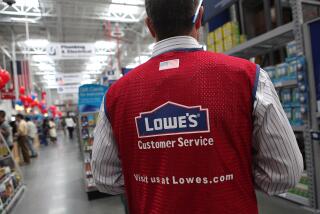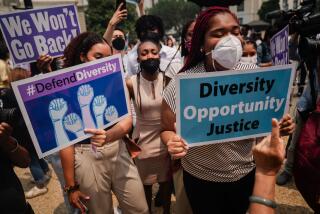Discrimination Case : Administration Fights Unhappily With Sears
CHICAGO — A strange brew of politics, law and civil rights percolates here in a 21st-floor courtroom where the Reagan Administration is pouring millions of dollars into a case it philosophically would prefer to lose.
The case is a federal suit against the nation’s largest retailer, Sears, Roebuck & Co., in which the Equal Employment Opportunity Commission charges Sears with discriminating against women. It is the last of several celebrated cases brought by a liberal, activist EEOC in the 1970s against corporate giants such as AT&T;, General Motors, General Electric and the steel industry.
While the other big firms settled the cases with back-pay awards and hiring plans for women and minorities, Sears braved the fire from the Carter Administration. Now it has a friendlier opponent: the Reagan Administration.
The Reagan-run EEOC has announced its intention to move away from class-action suits on employment discrimination in favor of smaller, individual suits for persons who can prove that they, specifically, were victims of bias.
In this case, Administration officials privately make little secret of their desire to lose the case, and lose it in a way that would explode any chance for future EEOC officials to bring class-action suits on the basis of statistics indicating that women or minorities are under-represented in a company’s work force.
At the same time, however, they’re nervous that losing the case by default would give more ammunition to their critics and could cost them millions in additional legal fees. So while top agency officials express reservations about the case, the lawyers keep plodding along in court.
EEOC Chairman Clarence Thomas has repeatedly criticized the case in public.
Statistical Evidence
“I personally have problems with cases that rely on statistical evidence of discrimination (in large firms),” Thomas told a congressional hearing after Rep. Augustus F. Hawkins (D-Calif.) asked whether Thomas thought it “appropriate for you, as chairman of the commission . . . to criticize (in newspapers) the commission’s own case while the case is still before the court.”
The EEOC “should not rely solely on statistics to process these (class-action) cases,” Thomas said. “That was my opinion and that continues to be my opinion. . . . I do not believe that every statistical disparity between races or ethnic (groups) or the sexes in the work force results from discrimination.”
Thomas is not alone. A high-ranking Justice Department official who has followed the Sears case, but who refused to be quoted publicly, describes it as a “straw man we would like to have beat to death to prevent future class-action cases” by the government.
Despite its antipathy to the case, the Administration continues to fund it at such high levels that EEOC officials issued a memorandum in May warning of the potential need for the agency to furlough all of its employes nationwide for one day to help pay for the case.
According to EEOC officials, the case has cost at least $2.5 million and at times has taken up more than a third of the agency’s litigation budget. Yet the Sears case is only one of more than 300 cases the agency has brought in the last year.
Legal Fees
That’s not all. If Sears wins the case, the company may ask the court to require the government pay its legal fees--which could run as high as $20 million, according to some estimates.
The potential damage to the agency as well as his own philosophical opposition to the case has put Thomas in a tight political spot. “I’ve been trying to get out of this since I’ve been here,” he said in an interview. “It’s a case brought by my predecessor during the Carter Administration, and even those people had doubts about it . . . “
“But politically, how could I get out of it?” he asked. “If I say, because I don’t like it I’m not going to put the money into it, then the liberals and everybody else would eat me alive. It’s like the Vietnam war to me--as long as we are in it, we should fight as hard as we can to win.”
Settlement Weighed
But even as the final arguments against Sears were presented here a week ago by EEOC’s lawyers, top agency officials in Washington were considering whether to ask Sears to settle out of court. Under the agreement, Sears would pay no fines or back-pay awards; in return, EEOC would be protected from the threat of having to pay Sears’ legal fees.
“Even the most gung-ho of the conservatives around here are concerned about the damage that will be done to the agency if we have to pay big money to Sears for its legal fees,” said one EEOC lawyer. “There’s some rethinking going on about keeping a lid on the cost of proving their point.”
Sears has tried to make use of the great divide between top EEOC officials and the agency’s legal staff that has labored on the case. Sears’ lawyers tried to have Thomas travel here to give a deposition after Thomas told reporters he believed that the case, and others like it, are part of the “overextended and over-applied” use of statistics.
The court ruled that Thomas’ opinion was not relevant. But Barry Goldstein, a lawyer for the NAACP Legal Defense Fund, asked at a congressional hearing: “I wonder how the lawyers . . . in Chicago on the Sears case feel about reading in the press their boss’ comment about their extensive efforts.”
Heads the Team
The EEOC’s lead counsel in the case, James Scanlon, 40, heads a team that includes two other lawyers and two assistants.
Scanlon would not comment on Thomas’ remarks about the case. But of the argument that statistical proof of discrimination is not proof unless specific women can prove they are victims of discrimination, Scanlon said:
“How many individual instances of discrimination would one need to show to offer meaningful evidence regarding the practices of a nationwide employer the size of Sears?
“Second, what does a person denied a position because of discrimination know about the circumstances of that decision? They don’t know whether there was a vacancy, much less anything about the qualifications of the person who was, in fact, hired.”
Scanlon added that a “pattern of discrimination” may exist in large companies when a pool of qualified applicants is considered but only white men, for example, win jobs.
In the closing days of the trial, under pressure from his superiors, Scanlon presented two women who testified that they believed they had been discriminated against by Sears.
Heart of the Case
Despite their testimony, the heart of the EEOC’s case remains statistical: While 60% of applicants for sales jobs at Sears from 1973 to 1980 were women, about 27% of the persons hired were women. In 1972, before Sears began an affirmative-action plan, 9.9% of such jobs went to women.
The EEOC’s study of the women applying for the jobs also found that 40% of them had experience in the type of sales job they sought.
The government is also charging Sears with not promoting women on its sales staff to commissioned sales jobs, which are potentially more lucrative. One Sears commissioned salesman testified that he earned about $175,000 a year.
The EEOC also contends that 72% of Sears noncommissioned sales staff was female but that fewer than half of the promotions to commissioned sales jobs--about 40%--went to women.
Sears has responded with testimony from economists, and with polls showing that women were not interested in commissioned sales jobs, which often are in fields such as house siding, plumbing and auto parts.
Unequal Interest
“Statistics can be helpful in the proof of some lawsuits,” said Charles Morgan, the former head of the Washington office of the American Civil Liberties Union who now represents Sears. “(The statistics) must relate to the real world, however, and have relevance to what it is that is being measured. Men and women are not equally interested in selling men’s clothes and women’s clothes. Men and women are not equally interested in selling drapes, plumbing, heaters, auto parts and truck tires.”
The legal fight has generated animosity between Sears’ senior managers and the EEOC. According to both sides, Sears officials have not wanted to settle the case but would rather defeat the EEOC and “celebrate”--a Sears official’s word--in return for being dragged by the EEOC through a decade of charges of racial and sex discrimination.
The animus between the two sides spilled into public light in 1979 when Sears filed suit against the federal government, charging it with creating a work force dominated by white males and thereby forcing Sears to hire white males. Sears said the government created that white male work force with veteran’s preferences and GI bill benefits. It contended that Social Security and welfare payments induced women not to work. It charged that federal age-discrimination laws had slowed the exit of white men from the company and thus the entrance of women and minorities.
The suit was dismissed.
On the Offensive
Since the Reagan Administration took office, Sears has been on the offensive. The government has backtracked on race-discrimination charges filed against Sears during the Carter years. In that settlement, the government agreed to allow Sears to avoid all back payments for victims of Sears’ alleged practice of “restricting blacks and Spanish-surnamed Americans to lower-paying, less desirable jobs,” and not hiring minorities.
Although Sears settled that suit, it has allowed the sex discrimination charges to drag on.
“They don’t want to settle,” said an EEOC official. “They want to win and they want to rub our noses in it.”
Sears officials note that they have had an affirmative-action plan requiring that women and minorities fill one of every two job openings--a quota--at the same time that the Reagan Administration is suing to halt the use of quotas around the nation.
“They are fighting us over discrimination but they wouldn’t even use a plan as strong as ours to do the job,” said a Sears official. “Now that’s hypocrisy.”
More to Read
Inside the business of entertainment
The Wide Shot brings you news, analysis and insights on everything from streaming wars to production — and what it all means for the future.
You may occasionally receive promotional content from the Los Angeles Times.










